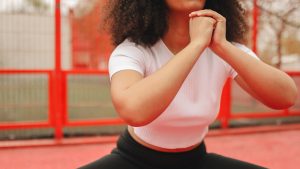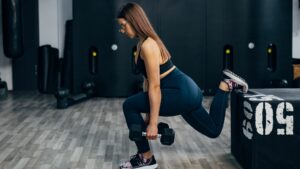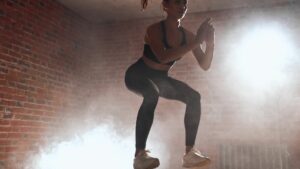Warm-up Routine
Before diving into squats, it’s crucial to warm up the muscles to prevent injury and optimize performance. Here’s a suggested warm-up:
a. Cardio Warm-up (5-10 minutes)
Engage in light cardio like jogging, cycling, or jumping jacks to increase heart rate and blood flow to the muscles.
b. Dynamic Stretches (5 minutes)
Perform dynamic stretches that target lower body muscles involved in squats, such as leg swings, hip circles, and walking lunges. This helps improve flexibility and range of motion.
c. Activation Exercises (5 minutes)
Activate specific muscles used in squats with bodyweight exercises like glute bridges, clamshells, and bodyweight squats. This helps activate and prepare the muscles for the upcoming squat routine.
Types of Squats
Incorporating a variety of squats can help target different muscles and prevent plateauing. Here are a few effective squat variations:
1. Bodyweight Squats
These are foundational and perfect for beginners. Focus on form and depth, keeping the back straight and knees aligned with the toes.

2. Goblet Squats
Hold a dumbbell or kettlebell at chest level while performing squats. This variation helps with balance and engages the core muscles.
3. Sumo Squats
Widen your stance with toes pointing outward. This targets the inner thighs more intensely.
4. Bulgarian Split Squats
Stand a few feet in front of a bench, with one foot elevated behind you. Lower into a lunge position, engaging the front leg. This variation emphasizes single-leg strength and balance.

5. Jump Squats
Add explosiveness to your routine by incorporating jump squats. Start in a squat position and explosively jump upward, landing softly back into a squat.

Cooling Down
After completing the squat routine, it’s essential to cool down and stretch the muscles. Perform static stretches targeting the quadriceps, hamstrings, calves, and hips to improve flexibility and reduce muscle soreness.
Remember, proper form is crucial to avoid injury. Start with a comfortable weight or bodyweight and gradually progress. Listen to your body and adjust as needed.
For more detailed guidance or specific routines, consulting with a certified trainer or physical therapist can be immensely beneficial.
Reps and Sets
Determining the number of repetitions (reps) and sets depends on individual fitness levels and goals. Here’s a general guideline:
Beginners: Start with 2-3 sets of 8-12 reps for each type of squat. Focus on proper form and gradually increase intensity.
Intermediate/Advanced: Aim for 3-5 sets of 6-10 reps with heavier weights or more challenging variations.
Rest Between Sets
Allow adequate rest between sets to recover while maintaining intensity. Typically, rest for 30 seconds to 1 minute for higher reps and up to 2 minutes for heavier sets.
Progression
Consistency is key. As strength and comfort increase, gradually increase weights, reps, or difficulty of the squat variations to challenge muscles and progress further.
Importance of Squats
Squats are a powerhouse exercise beneficial for:
Building Leg Strength: Engaging various muscles in the lower body, including quadriceps, hamstrings, glutes, and calves.
Functional Movement: Mimicking daily activities like sitting, standing, and lifting.
Core Engagement: Proper squat form also engages core muscles, promoting overall stability and strength.
Final Thoughts
Remember, warming up properly and executing squats with correct form are crucial. Alongside squats, incorporate a well-rounded workout routine that includes other lower body and core exercises for balanced strength development.
Always consult a fitness professional or trainer for personalized guidance, especially if you have any pre-existing conditions or concerns.
Squats, when performed correctly and integrated into a holistic fitness routine, can contribute significantly to overall strength, stability, and functional movement.
So, lace up those sneakers, get warmed up, and enjoy the journey of incorporating squats into your fitness routine! Your body will thank you for it.
External Resources:
Advanced Squat Techniques for Greater Strength – Muscle & Fitness
Benefits of Squats for Women – Women’s Health
Tips for Proper Squat Form – Healthline
Bodyweight Squats – Proper Form Guide – ACE Fitness
Variations of Squats for Lower Body Strength – Self
Importance of Warm-up and Cool-down – Mayo Clinic
Now you’re equipped with a robust understanding of different squats and an effective warm-up routine. Dive in and enjoy your workout.
Comparison tabular
| Type of Squat | Description | Primary Muscles Targeted | Difficulty Level | Equipment |
|---|---|---|---|---|
| Bodyweight Squats | Fundamental squat using only bodyweight. | Quadriceps, Glutes, Hamstrings, Core | Beginner | None |
| Goblet Squats | Involves holding a weight at chest level while performing squats. | Quadriceps, Glutes, Hamstrings, Core | Beginner | Dumbbell/Kettlebell |
| Sumo Squats | Requires a wider stance with toes pointed outward. | Inner Thighs, Glutes, Quadriceps | Intermediate | None |
| Bulgarian Split Squats | Single-leg squat variation with one foot elevated behind. | Quadriceps, Glutes, Hamstrings, Core | Intermediate | Bench |
| Jump Squats | Adds explosiveness by incorporating a jump at the top of the squat. | Full Lower Body, Explosive Power | Intermediate | None |
Comparison Overview:
Primary Muscles Targeted: Each type of squat primarily engages different muscle groups, contributing to overall lower body strength and stability.
Difficulty Level: Ranges from beginner-friendly (like bodyweight squats) to intermediate levels requiring more balance and strength (such as jump squats).
Equipment: Some squats can be performed solely with bodyweight, while others may require additional equipment like dumbbells or a bench.
This comparison table can help you choose which squat variations align with your fitness goals and current fitness level. Remember to prioritize proper form over intensity and gradually progress to more challenging variations as you become more comfortable.
Feel free to use this table as a reference when planning your squat routine.
Wrapping it up
Squats are a versatile and effective exercise that can be tailored to various fitness levels and goals. Whether you’re a beginner looking to build strength or an experienced fitness enthusiast aiming to challenge yourself, incorporating squats into your routine offers numerous benefits.
Key Takeaways:
Form Matters: Prioritize proper form over the number of reps or weight used. Correct form minimizes injury risk and maximizes muscle engagement.
Variety is Key: Experiment with different types of squats to target various muscles and prevent workout plateaus. This diversity keeps your routine engaging and effective.
Listen to Your Body: Pay attention to how your body responds to different squat variations. Progress gradually and adjust based on comfort and capability.
Holistic Approach: Squats work in synergy with other exercises. Consider incorporating complementary movements to strengthen the entire lower body.
Consult a Professional: If you’re new to squats or have specific fitness goals, seeking guidance from a certified trainer can be immensely beneficial.
Remember, consistency and dedication are the pillars of progress. As you embark on your squat journey, enjoy the process, celebrate your achievements, and prioritize your overall fitness and well-being.
So, lace up your shoes, embrace the burn, and squat your way to stronger, healthier legs and a more robust physique

Hey there, it’s Mike Rrsq, the Editor-in-Chief over at Jsquat.com, and I’m absolutely obsessed with all things squat fitness! I’ve been lucky enough to get some serious recognition for my work in this field. With a solid background in the fitness and wellness industry, I’ve been there right from the get-go, helping shape this website into what it is today.
You see, I’m not just the boss around here; I’m also a passionate contributor. I love sharing my insights through my articles, and trust me, they’re not your run-of-the-mill stuff. Each piece I write is a labor of love, filled with my expertise and real-world experience in the fitness universe. So, if you’re into fitness and looking for some inspiration, you’re in the right place!
Related Posts
- Best 3 most effective squat variations you need for targeting the adductor magnus.
Squat is one of the most effective exercises that you can do to target quads…
- The Best 3 Most Effective Squat variations for targeting the obliques.
Squats are renowned for their ability to strengthen and tone the lower body, but did…
- The Top 3 Effective Squat Variations you need for better swimming performance.
Swimming is an intricate sport that demands a blend of strength, endurance, and technique. While…
- The best 5 most effective squat variations you need for better basketball performance
Basketball demands a unique blend of strength, agility, and explosive power. Choosing the right squat…
- The best 3 most effective squat variations you need for better soccer performance.
Squats are a foundational exercise for athletes across various sports, and for soccer players, they…
- The top 3 effective squat Variations 19-year-old males need to build explosive strength
Squats are foundational exercises for enhancing lower body strength and power. For a 19-year-old male…
- The Top 3 Effective Squat Variations you need for better volleyball performance
Volleyball demands agility, power, and endurance. As an athlete, fine-tuning your performance can be the…
- Best 3 Most Effective Squat Variations you need for targeting the transverse abdominis.
When it comes to strengthening the core, especially the often elusive transverse abdominis, selecting the…
